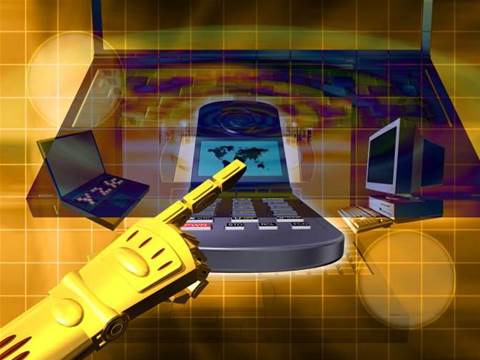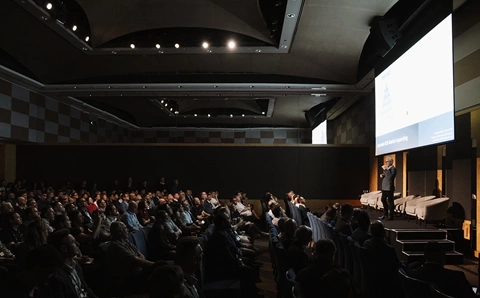With times being tougher than any other period in recent history, this year's Mobile World Congress was somewhat more subdued than previous years, but nonetheless around 47,000 exhibitors, visitors and media flocked to Barcelona to see what new devices, technologies, services and applications the mobile industry has to offer.
After a hectic few days covering all the latest developments from the show it is time to look back and reflect on the highs and lows, what made us glad and what made us sad.
The Best...
1. I-mate
I-mate gets my top spot for two reasons: firstly they have unveiled three truly innovative new mobile devices; and secondly the company's chief executive, the aptly named Jim Morrison, is a refreshingly open and honest person to chat to. He must be a PR's worst nightmare.
Just before the show I-mate unveiled the 810-F, a ruggedised smartphone that gets its name from the fact that it meets the US military's MIL-STD-810F specifications, which means it is resistant to dust, humidity, shock and vibration, extreme temperatures and can even be fully immersed in water.
During the show, I-mate unveiled a new dinky little smartphone, codenamed Centurion, which is not much bigger than a credit card but will run Windows Mobile 6.5 and sports a full Qwerty keyboard that you can somehow actually type on. It is due out around the middle of 2009 and should cost around US$550 (£386).
I-mate was also showing press a pair of new linked products currently being developed, dubbed Legionnaire and Warrior (also code names).
The first is a good looking, but fairly standard touch-screen smartphone, also set to run on Windows Mobile 6.5. When it gets interesting is when it is partnered with Warrior, which is essentially a notebook that has had its innards replaced with batteries. Legionnaire docks below the Warrior's keyboard, and the combination basically creates a notebook powered by the phone, but with a full-sized keyboard and screen. The phone's touch-screen becomes the touchpad and users will have the option of either running Windows Mobile on the larger display or creating a remote desktop to their PC or Mac at home or in the office.
As if the prospect of no longer shifting between multiple devices wasn't appealing enough, I-mate has used the space that would be taken up by the laptop's circuitry to pack in extra batteries. Morrison reckons it will provide around 58 hours of continuous use and will charge the phone at the same time.
Legionnaire and Warrior are due out in the third quarter of 2009 and expected to cost around US$500 (£351) and US$199 (£140) respectively.
2. App stores
Say what you will about the iPhone, its impact on the mobile industry cannot be denied. This includes the iTunes App Store, which gives users a centralised repository of applications, content and services for their device.
Although a few third parties have had online mobile application stores for years, these have usually been limited in the scope of content, as well as payment and delivery options. Previously users wanting access to a feature not pre-installed on the phone typically have had to hunt it down online, pay for it via credit card, download it to a PC, sideload it onto the device and then pray that it worked properly.
It seems the powers that be have finally realised that app stores not only make it easier for users to find the types of applications and media they are looking for, but provides a great new delivery channel for developers, content providers and marketers.
3. Standard mobile phone charger
A round of applause broke out when GSMA boss Rob Conway announced that by 1 January 2012 the majority of all new mobile phones will use an energy efficient universal charging connector based on micro-USB.
Finally we'll be able to do away with a drawer full of different chargers and we can hope to see the cost of new handsets come down slightly as they will not need to all have a charger bundled in with them. If your phone is running out of power but you forgot to bring your charger, anyone else who does have one to hand can lend you theirs.
Apple was conspicuous by its absence from the list of companies who agreed to the new standard, so we are pretty sure we won't be seeing a new iPhone with a micro-USB connector any time soon.
4. 16GB microSD
Memory makers SanDisk and Kingston have both just released 16GB microSD cards.
I'm only 30 years old and I can still remember carefully deleting things from my dad's 20MB hard drive so I could squeeze on a copy of Star Wars: X-Wing, so to hold something roughly the size and thickness of my fingernail that can hold 800 times that is quite awe inspiring.
The ceaseless march of technology means that we were bound to get to this point eventually, and SanDisk told us they have already developed processes to take that up to 32GB in the not too distant future. But there is still something amazing about these little things (until you drop it on the carpet and have to spend 20 minutes hunting for it).
5. Barcelona
This was the third year that Mobile World Congress was held in Barcelona, an amazing city both culturally and aesthetically. Thanks to the strong influence of Antoni Gaudi and the general Spanish culture, it's a truly beautiful city to behold.
It's also well laid out for the most part and the public transport is extremely good, making it perfect for an event like MWC. The show was originally held in Cannes, and although I never attended, I've heard the tales from colleagues and fellow journalists and having been to Cannes on several occasions, I can imagine the nightmare it must have been.
The downside to Barcelona, especially during events like MWC, is that theft and pick-pocketing is rife. While you have to keep a close eye on your belongings at all times, there is hardly any violent crime, so you may have your wallet lifted while walking down Las Ramblas, but the chances of being mugged are very slim.
Seeing how well Barcelona's Metro compares to the London Tube, I despair for the London Olympics in 2012.
The Worst...
1. Motorola
Certainly the most absurd device we saw at the show has to be Motorola's Diamond Aura phone, which will cost an eye-watering £5,000 and it isn't even very good.
Based on the company's odd-looking rotator design Aura phone and designed by luxury phone maker Alexander Amosu, the white gold encased device has 99 diamonds embedded in it totalling about one carat. It also includes a one-year free international concierge service in 44 cities around the world.
For those flying in the face of the economic downturn, the Diamond Aura is set to go on sale at Selfridges in March, but you'd better get your order in now as only 50 of these are going to be made.
2. WiMax
The battle between WiMax and LTE as king of 4G mobile access was a hot topic at this year's MWC.
WiMax is further down the development path with many trials well underway or recently completed and some commercial rollouts already done. However, many seem to consider LTE to be a stronger contender and are willing to rely on existing 3G technologies until LTE matures.
During the show there were a lot of WiMax network providers insisting that the technology is still viable, but the resounding lack of operators talking about it and the dearth of devices supporting it speaks volumes about its potential.
3. More of the same
This year's show saw almost every handset manufacturer under the sun launch at least one new device, but the lack of innovation in the majority of these new products meant it quickly became difficult to remember which one was which.
4. Events far away from the grounds
As mentioned earlier I'm fond of Barcelona and it's a great location for Mobile World Congress, however, it's a pretty big city and cramming in as much as I do in three days makes it an extremely hectic time.
With this in mind, why on earth do companies insist on holding events that are far away from the showground? The show itself spans eight large halls and getting from one end to the other can take half an hour at brisk pace, so the concept of then having to fight your way through throngs of people, find a taxi, bus or Metro stop and head out to an event is extremely offputting and more than likely going to make visitors opt for one of the other deluge of invitations for briefings, launches or interviews in the showground.
5. Android
Android makes it onto our worst list, not because we don't like Google's open source mobile operating system (quite the contrary, in fact), but because it was almost entirely absent from a show where it should have been one of the hottest topics around.
With so many manufacturers joining the Open Handset Alliance in recent months we were expecting to see a plethora of new phones running Android being unveiled at MWC, but pretty much the only Android related announcement was the HTC Magic, and even that was fairly lacklustre at it is essentially the same design as the G1, but without the keyboard.
Top 10 best and worst of MWC 2009
By
Staff Writers
on Feb 21, 2009 8:59AM

Got a news tip for our journalists? Share it with us anonymously here.
Partner Content

Shared Intelligence is the Real Competitive Edge Partners Enjoy with Crayon
_(21).jpg&h=142&w=230&c=1&s=1)
Empowering Sustainability: Schneider Electric's Dedication to Powering Customer Success
.png&h=142&w=230&c=1&s=1)
How mandatory climate reporting is raising the bar for corporate leadership

Beyond the box: How Crayon Is Redefining Distribution for the Next Era

MSPs with a robust data protection strategy will achieve market success
Sponsored Whitepapers

Cut through the SASE confusion

Stay protected as cyber threats evolve

Defend Your Network from the Next Generation of AI Threats
.jpg&w=100&c=1&s=0)
The race to AI advantage is on. Don’t let slow consulting projects hold you back.
_(8).jpg&w=100&c=1&s=0)
The changing face of Australian distribution












